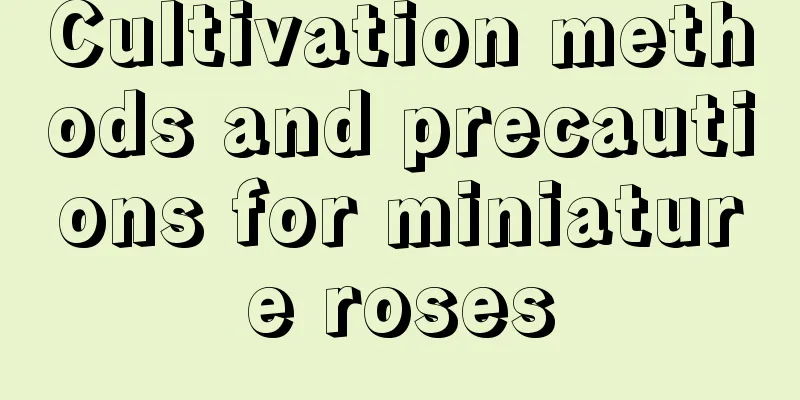Cultivation methods and precautions for miniature roses

Farming methodsWateringMiniature rose plants have small roots and shallow roots. The soil in the pot should be kept moist before germination in spring. Do not water unless the soil is dry. After germination, gradually increase the amount of watering. Generally, water once before 10 am every day, and water appropriately in the afternoon according to the dryness and wetness of the soil in the pot. In summer, water should be poured once in the morning and once in the evening, and generally not poured at night. FertilizationMiniature roses like fertilizer. When they grow vigorously in spring and autumn, they should be fertilized once every 10 to 15 days. Both organic fertilizer and compound fertilizer can be used. Fertilization should be stopped during the hot summer season and the cold winter season. ReproductionMiniature roses are mostly propagated by cuttings, but can also be propagated by division and layering. Cuttings can be carried out all year round, but it is better to use stem cuttings in winter or autumn. When using green branch cuttings in summer, attention should be paid to water management and temperature control. Grafting propagation can also be used. Thornless roses are often used as rootstocks, and branch grafting is done in early spring or bud grafting is done during the growing season, especially bud grafting, which has a better effect. PrecautionspruneAfter the flowers fade, some branches should be cut off, leaving new branches for 2 to 3 nodes before cutting them off. Branches with more than 2 nodes can be used for cutting propagation. Pruning in winter is mainly for shaping. First, cut off dead branches, diseased and insect-infested branches, and cross-branched thin branches. For plants that are growing vigorously and have a symmetrical shape, cut off 1/3 of the whole plant. For weak plants, cut off about 2/3 of the plant, leaving 3 to 4 strong main branches. RepottingTurn the pot every 1 to 2 years, remove about 2/3 of the old soil, and replace it with loose, fertile soil rich in organic matter. It is usually carried out before the buds sprout in spring, combined with repotting, cutting off dead roots, rotten roots, diseased and insect-infested roots, shortening excessively long roots, thinning out dense roots and some old roots, to promote the sprouting of new roots and promote vigorous growth. Pest controlThe main diseases of miniature roses are powdery mildew, gray mold, and black spot. Common pests include aphids, red spiders, and leaf-cutter bees. The main prevention and control methods are to carry out scientific cultivation, enhance the disease resistance of plants, and remove dead branches and leaves in time. You can also go to the flower market to buy special pesticides for spraying to eliminate pests. |
<<: Cultivation method of purple-backed Dieffenbachia
>>: Succulent Plant Soil Encyclopedia
Recommend
How to grow golden grass
How to grow golden grass Golden grass is a light-...
The propagation method of Huaye Hanyueye
Cutting propagation Time selection: Time selectio...
How to deal with calla lily root rot
1. How to deal with it 1. Reasons First, it may b...
How to plant Xanthoceras sorbifolia in pots
1. Prepare the soil If you are planting in pots, ...
How to grow snow lotus
1. Maintenance methods 1. Temperature: Snow lotus...
Does mint need to be pruned? What are the precautions for pruning?
Pruning is good for mint, as it can keep its plan...
The efficacy and function of hawthorn
1. Cancer prevention and anti-cancer Studies have...
How to save onion seeds
Green onion seeds introduction Onions have seeds....
Is it okay to put an egg in the green radish? Can I put eggs directly in the green radish?
1. Can you put an egg in it? It is a good idea to...
How to breed Sakura crystal and what to pay attention to
How to reproduce Sakura crystal The propagation m...
How to identify lychee grass
1. Blades The leaves of Litchi grass are elliptic...
Varieties of Plane Flower
A variant of the plane flower, the small plane fl...
It can kill bacteria and beautify the skin, and it is also edible. If you cut one piece of this flower, it can turn into 10 pots. You will have too many of them at home!
One pot turns into ten pots, this is how to propa...
How to prune silk cotton wood
When to prune the silk cottonwood The silk cotton...
Watermelon and cucumber... No need to buy them anymore, just grow some on the balcony and you can eat more
Growing watermelons on the balcony Planting time:...









